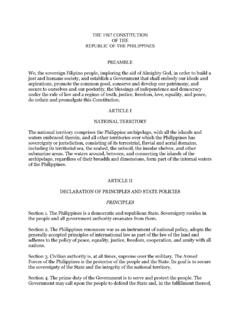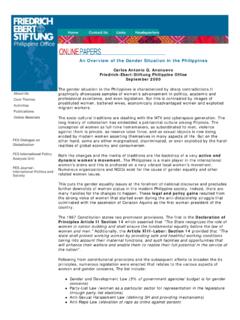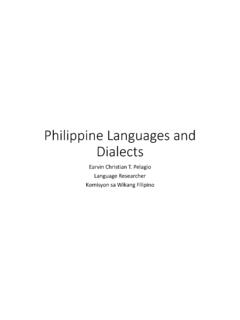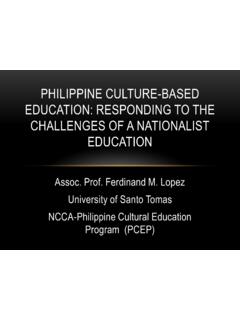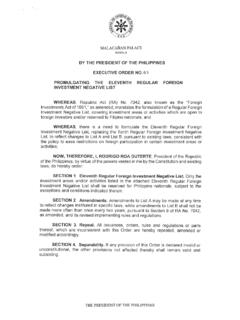Transcription of WHAT IS GOOD ABOUT THE 1987 CONSTITUTION?
1 Even before coming to power, President Rodrigo Roa Duterte had been casting federalism as our last hope to set right the excesses of a central government controlled by Imperial Manila, the inequitable distribution of public resources, the uneven economic development among regions, and the massive poverty that has bred unrest and rebellion in Mindanao. The shift to a federal system of government necessitates changing the existing constitution . In December 2017, through Executive Order 10, the president formed a 25-member consultative committee to review the 1987 constitution and study proposals for its revision. In the House of Representatives, technical working groups have been created to draft a philippine Federal constitution .
2 Two proposals one by the president s political party, the Partido Demokratiko Pilipino Lakas ng Bayan (PDP-Laban), another by his allies in the House of Representatives have been put before we throw the 1987 constitution out, prudence requires that we examine what is good ABOUT it, among them, the provisions on social justice and human rights. This issue of Intersect Quick Facts hopes to help readers better appreciate our current constitution and decide whether we should be discarding it for the extravagant promises of President Duterte s federalist project. Perhaps, to paraphrase English Catholic journalist and social activist Gilbert Keith Chesterton ABOUT Christianity, the real problem with the 1987 constitution is not that it has been tried and found wanting, but that it has been found difficult and left IS GOOD ABOUT THE 1987 constitution ?
3 ATTEMPTS AT CHANGING THE CHARTERVOL. V NO. 1 QUICK FACTSJANUARY 2018 RESEARCH BY Anna Marie V. Alhambra Marvee Anne M. Ramos EDITING BY Eleanor R. Dionisio COVER PHOTO AND LAYOUT BY Gerald M. NicolasAfter the overthrow of Ferdinand Marcos in 1986, Aquino created a Constitutional Commission with 48 members to propose a post-dictatorship constitution . Ratified overwhelmingly on February 2, 1987 through a national plebiscite, the new constitution stressed the importance of human rights and popular participation in governance (IPER 2004, 14). It also incorporated safeguards for freedom and democracy, among them strict requirements for the declaration of Martial C. AQUINO1986-1992 Ramos, the first president to be elected under the 1987 constitution , attempted to change the constitution twice first in 1995 and second in 1997.
4 Civil society groups perceived the move as a ploy to allow him to seek a second term (IPER 2004, 15).FIDEL V. RAMOS1992-1998 Estrada created a commission to study the possibility of amending the economic and judiciary provisions of the constitution . The commission ceased its work after civil society organizations opposed its proposal to allow foreign entities to own prime lands in the country (IPER 2004, 16). JOSEPH E. ESTRADA1998-2001 Allies of Arroyo in Congress proposed a shift to a unitary parliamentary system and other political reforms to be introduced by a Constituent Assembly (Con-Ass). Civil society groups opposed the preferred mode of changing the constitution because it left the crafting of the new charter to politicians who might build their own interests into its provisions (IPER 2004, 12).
5 GLORIA M. ARROYO2001-2010 Aquino initially disapproved of constitutional change but eventually became open to it to limit the judiciary s power in relation to the executive and legislative branches of government, and to continue reforms by allowing the incumbent president to run for a second term (Ubac and Bordadora, 2013; Calonzo 2014; Gutierrez 2014).BENIGNO S. AQUINO III2010-20162 The 1987 constitution upholds workers rights of all Filipinos, local and overseas, through security of tenure, humane working conditions, and a living wage. It also recognizes workers rights to organize themselves and to strike (Art. XIII, Sec. 3).LABORSOCIAL JUSTICEThe 1987 constitution aspires to protect human dignity and reduce economic and cultural inequities through the distribution of wealth and power for the common good.
6 Its provisions on social justice labor, agrarian and natural resources reform, urban land reform and housing, health, women, and people s organizations put the poor at the center of our development as a nation (Monsod 2017).The Department of Labor and Employment released two department orders protecting security of tenure, one in 2011 (DO 18-1 s. 2011) and another in 2017 (DO 174 s. 2017), which prohibit labor-only contracting or 1995, Congress enacted the Migrant Workers and Overseas Filipinos Act (Republic Act 8042) and amended it in 2009 (RA 10022) to protect migrant workers against abuses such as illegal recruitment and trafficking, and to promote their welfare and that of their families.
7 While the regulatory framework and institutions created by our laws to protect overseas Filipino workers (OFWs) are considered a model for many developing countries, the implementation of the framework and performance of the institutions need to be strengthened (Orbeta, Abrigo, and Cabalgin 2009). For example, the government needs more strictly to implement bilateral agreements, as well as penalties for domestic agencies with violations, and to observe selective deployment to countries recognizing and protecting workers rights in accordance with the HAVE WE GAINED BECAUSE OF IT?The PDP-Laban draft federal constitution does not guarantee the humane conditions of work and a living wage enshrined in the 1987 constitution .
8 Instead it proposes freedom from discrimination on matters of employment tenure, working conditions, and wage levels. A footnote says that sections on labor are better left to Parliament (PDP-Laban 2017, 59).WHAT S IN THE PROPOSED REVISIONS?ICON MADE BY VECTORS MARKET FROM The Comprehensive Agrarian Reform Law or CARL (RA 6657) was enacted in 1988 to distribute public and private agricultural land to landless farmers and farm workers through a 10-year Comprehensive Agrarian Reform Program (CARP). CARP was extended for another 10 years in 1998 by the enactment of the Augmentation Fund for CARP Implementation (RA 8532), and further extended in 2009 by the enactment of CARP Extension with Reform or CARPER (RA 9700).
9 By 2016, million hectares of eligible land had been distributed, benefiting million agrarian reform beneficiaries (ARBs); the balance to be distributed is 600,504 hectares of private agricultural land (Ballesteros, Ancheto, and Ramos 2017).The Indigenous People s Rights Acts or IPRA (RA 9371) was enacted in 1997. The law defines the concept of ancestral domain and mandates that indigenous peoples (IPs) be given certificates of ancestral domain title (CADTs). By June 2015, the National Commission on Indigenous Peoples (NCIP) had issued 182 CADTs (TEBTEBBA 2016). Much more needs to be done to speed up the registration of these lands with the Land Registration Authority and the development of Ancestral Domain Sustainable Development and Protection Plan (ADSDPP) to protect the ancestral domains from business interests and public projects that are detrimental to the interests of indigenous policies on aquatic resources had been in place since the 1930s, it was not until 1998, through the Fisheries Code (RA 8550), that poverty among small fishers was explicitly attributed to the depletion of fish stock, degradation of fishing grounds, and conflicting uses of coastal waters.
10 To address these problems, the law designated municipal waters of up to 15 kilometers from the shore for exclusive use by municipal fishers organizations and cooperatives. The amended Fisheries Code (RA 10654) further protected small fishers from commercial fishers by setting higher penalties. WHAT HAVE WE GAINED BECAUSE OF IT?The PDP-Laban draft federal constitution conspicuously lacks provisions for agrarian reform or support for its beneficiaries. It also lacks provisions for protecting the rights of farmers, fishers, and indigenous peoples, the sectors whose poverty rates are highest in the country. A footnote says that sections on agrarian reform and natural resources are better left to Parliament (PDP-Laban 2017, 59).
